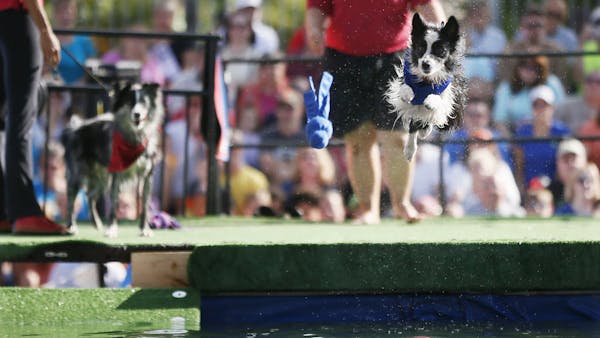Fran Holmsten stood at the edge of a long walkway in her stocking feet, hands at her sides.
When she heard the signal, she nodded a few times, walked several steps forward, paused, spun around and walked back.
On a computer monitor beside her, the path she'd taken was visible in soft gray and white, like footsteps in the snow.
Holmsten, 71, and her husband, Dick, 74, were visiting the University of Minnesota's new Driven to Discover building at the State Fair for the second time in a week. The building, where dozens of U researchers are working over the fair's 12 days, gives fairgoers a chance to participate in studies on everything from medicine to social science.
The Holmstens volunteered Thursday for a Parkinson's disease study measuring how participants walk, sleep and perceive odors — all things that are diminished by the disease. The huge cross-section of people at the fair gives researchers a chance to examine gait, sleep and sense of smell in people without Parkinson's.
Lead researcher Colum MacKinnon, an assistant neurology professor at the U, said finding participants is typically a long, arduous process.
"If we need to know what the normative population [those unaffected by disease] is doing, we post fliers, we put ads in the paper, we go on the radio and we ask people to volunteer," he said. "And sometimes it works, and sometimes it doesn't."
Corjena Cheung, an assistant professor in the U's School of Nursing, is working with four other faculty members to study fitness in adults over 55. She said the team recruited about 300 people during its first three days at the fair.
"For something like this, to be able to recruit 100 people in one day, that's really unusual," she said.
In addition to the research happening in real time, the Driven to Discover building is a place for researchers to recruit for future studies — to create, in effect, a Rolodex of willing participants.
At a booth called "Social Science on a Stick," participants take personality and reaction-time tests, and provide basic information about themselves.
The goal is to recruit an array of people for future social science research, said third-year psychology Ph.D. student Pierce Ekstrom. Often, he said, participants in these kinds of studies are college undergraduates, who tend to be more liberal than average.
"When you're trying to understand processes behind political ideology, for example, it's really important to get the whole sample," Ekstrom said.
Tim Church is another researcher looking for a diverse sample of Minnesotans. A professor in the U's School of Public Health, he's using the fair to put together a database of people for future Parkinson's studies.
Minnesota has higher rates of the disease than other states, and it's not clear why. Researchers are wondering whether it has something to do with genetics or exposure to toxins. For one study, Church said, they're putting together a group of 1,200 Minnesotans — half with Parkinson's and half without — to find out everything from what jobs they've had to where they've lived to what their DNA looks like.
With that information, he said, they may be able to identify and treat the disease earlier.
'We're going to do all of them'
U alumni flocked to the building, which was adorned in the signature maroon and gold and splashed with the "Driven to Discover" slogan.
Marshall Hoff, 65, graduated from the U and then worked there for 36 years.
"I've been there all my life," he said.
After wandering through Wednesday to check out what the building had to offer, he returned Thursday to participate in the nursing school's fitness study.
"I thought I was in pretty good shape," he said, "so I wondered what this study would show me."
The result? "I'm in pretty good shape."
Sandy Ahlberg graduated from the U in 1973. The 63-year-old had seen the Driven to Discover building and its potpourri of study offerings on TV, she said.
"I thought, 'We're going to do all of them,' " she said.
As the cloudy afternoon wore on, Fran Holmsten, also a U alumna, glanced around the building for other things to do. As her husband finished up the Parkinson's study and sat down to put on his shoes, she pointed out a fitness test he might be interested in.
"I don't go to the fair to eat. A lot of people do; I just don't," she said. "There are so many things to see and do."
Outside, a group of couples danced on a small stage, music blaring. A taffy stand clicked and whirred as the machine inside it spun a thick mass of sugar, and the smell of fried dough wafted through the air.
Emma Nelson • 952-746-3287

Meet the Athena Award winners: 103 female athletes picked by their schools

5 vinyl shops in greater Minnesota worth a spin for Record Store Day

Scoggins: Hot Suns loom, and Finch feels the heat

Brooks: A tale of 124 hoarded Minnesota cats has at least a hundred happy endings

